A Robust Fully-Integrated Digital-Output Inductive CMOS-MEMS Accelerometer with Improved Inductor Quality Factor
Abstract
:1. Introduction
2. Operation Principle
3. Design and Simulation
3.1. Effect of Residural Stress on MEMS Sensing Structures
3.2. Accelerometer Structure Design
3.3. Oscillator Design
3.4. Mixer, Low-Pass Filter, and Counter Design
4. Results and Discussion
4.1. CMOS and Post-CMOS Fabrication
4.2. Accelerometer Characterization
4.2.1. Oscillator Test
4.2.2. Static Acceleration Test
4.2.3. Dynamic Acceleration Test
5. Conclusions
Author Contributions
Funding
Acknowledgments
Conflicts of Interest
References
- Zhang, G.; Xie, H.; de Rosset, L.E.; Fedder, G.K. A lateral capacitive CMOS accelerometer with structural curl compensation. In Proceedings of the 12th IEEE International Conference on Micro Electro Mechanical Systems, Orlando, FL, USA, 21 January 1999. [Google Scholar]
- Tsai, M.-H.; Liu, Y.-C.; Liang, K.-C.; Fang, W. Monolithic CMOS-MEMS pure oxide tri-axis accelerometers for temperature stabilization and performance enhancement. J. Microelectromech. Syst. 2015, 24, 1916–1927. [Google Scholar] [CrossRef]
- Tseng, S.-H.; Lu, M.S.; Wu, P.-C.; Teng, Y.-C.; Tsai, H.-H.; Juang, Y.-Z. Implementation of a monolithic capacitive accelerometer in a wafer-level 0.18 µm CMOS MEMS process. J. Micromech. Microeng. 2012, 22, 055010. [Google Scholar] [CrossRef]
- Chiu, Y.; Hong, H.-C.; Wu, P.-C. Development and characterization of a CMOS-MEMS accelerometer with differential LC-tank oscillators. J. Microelectromech. Syst. 2013, 22, 1285–1295. [Google Scholar] [CrossRef]
- Haris, M.; Qu, H. A CMOS-MEMS piezoresistive accelerometer with large proof mass. In Proceedings of the 5th IEEE International Conference on Nano/Micro Engineered and Molecular Systems, Xiamen, China, 20–23 January 2010. [Google Scholar]
- Chiu, Y.; Huang, T.-C.; Hong, H.-C. A three-axis single-proof-mass CMOS-MEMS piezoresistive accelerometer with frequency output. Sens. Mater. 2014, 26, 95–108. [Google Scholar]
- Liao, K.-M.; Chen, R.; Chou, B.C.-S. A novel thermal-bubble-based micromachined accelerometer. Sens. Actuators A Phys. 2006, 130, 282–289. [Google Scholar] [CrossRef]
- Liao, Y.-T.; Biederman, W.J.; Otis, B.P. A fully integrated CMOS accelerometer using bondwire inertial sensing. IEEE Sens. J. 2011, 11, 114–122. [Google Scholar] [CrossRef]
- Chiu, Y.; Hong, H.-C.; Chang, C.-M. Three-axis CMOS MEMS inductive accelerometer with novel Z-axis sensing scheme. In Proceedings of the 19th International Conference on Solid-State Sensors, Actuators and Microsystems, Kaohsiung, Taiwan, 18–22 June 2017. [Google Scholar]
- Chiu, Y.; Hong, H.-C.; Lin, C.-W. Inductive CMOS MEMS accelerometer with integrated variable inductors. In Proceedings of the 29th International Conference on Micro Electro Mechanical Systems, Shanghai, China, 24–28 January 2016. [Google Scholar]
- Passeraub, P.A.; Besse, P.A.; Bayadroun, A.; Hediger, S.; Bernasconi, E.; Popovic, R.S. First integrated inductive proximity sensor with on-chip CMOS readout circuit and electrodeposited 1 mm flat coil. Sens. Actuators A Phys. 1999, 76, 273–278. [Google Scholar] [CrossRef]
- Matheoud, A.V.; Solmaz, N.S.; Frehner, L.; Boero, G. Microwave inductive proximity sensors with sub-pm/Hz resolution. Sens. Actuators A Phys. 2019, 295, 259–265. [Google Scholar] [CrossRef]
- Wang, H.; Chen, Y.; Hassibi, A.; Scherer, A.; Hajimiri, A. A frequency-shift CMOS magnetic biosensor array with single-bead sensitivity and no external magnet. In Proceedings of the International Solid-State Circuits Conference, San Francisco, CA, USA, 8–12 February 2009. [Google Scholar]
- Yeh, S.K.; Fang, W. Inductive micro tri-axial tactile sensor using a CMOS chip with a coil array. IEEE Electron Device Lett. 2019, 40, 620–623. [Google Scholar] [CrossRef]
- Vogel, J.G.; Chaturvedi, V.; Nihtianov, S. Eddy-current sensing principle in inertial sensors. IEEE Sens. Lett. 2017, 1, 2500504. [Google Scholar] [CrossRef]
- Tseng, S.-H.; Hung, Y.-J.; Juang, Y.-Z.; Lu, M.S.-C. A 5.8-GHz VCO with CMOS-compatible MEMS inductors. Sens. Actuators A Phys. 2007, 139, 187–193. [Google Scholar] [CrossRef]
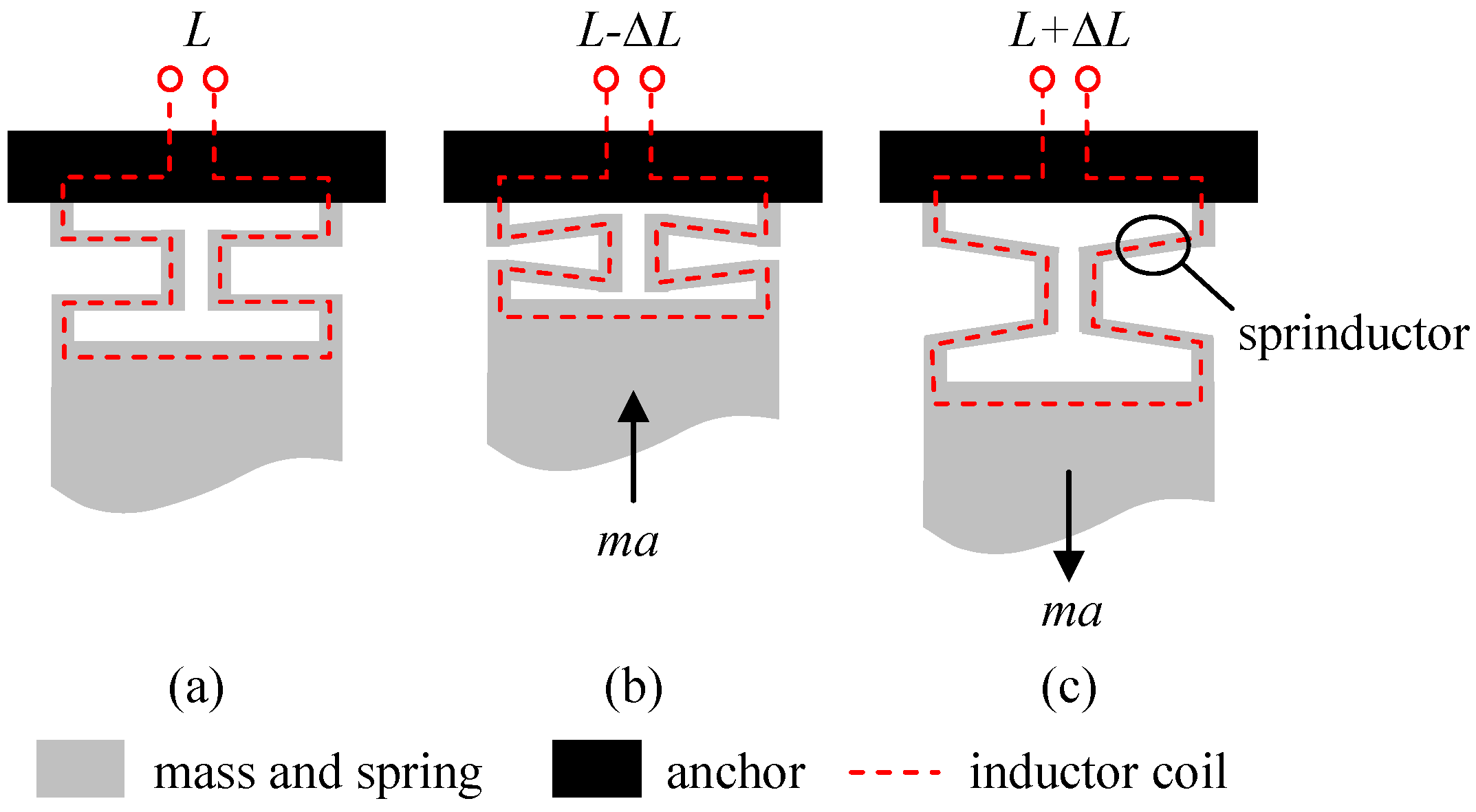


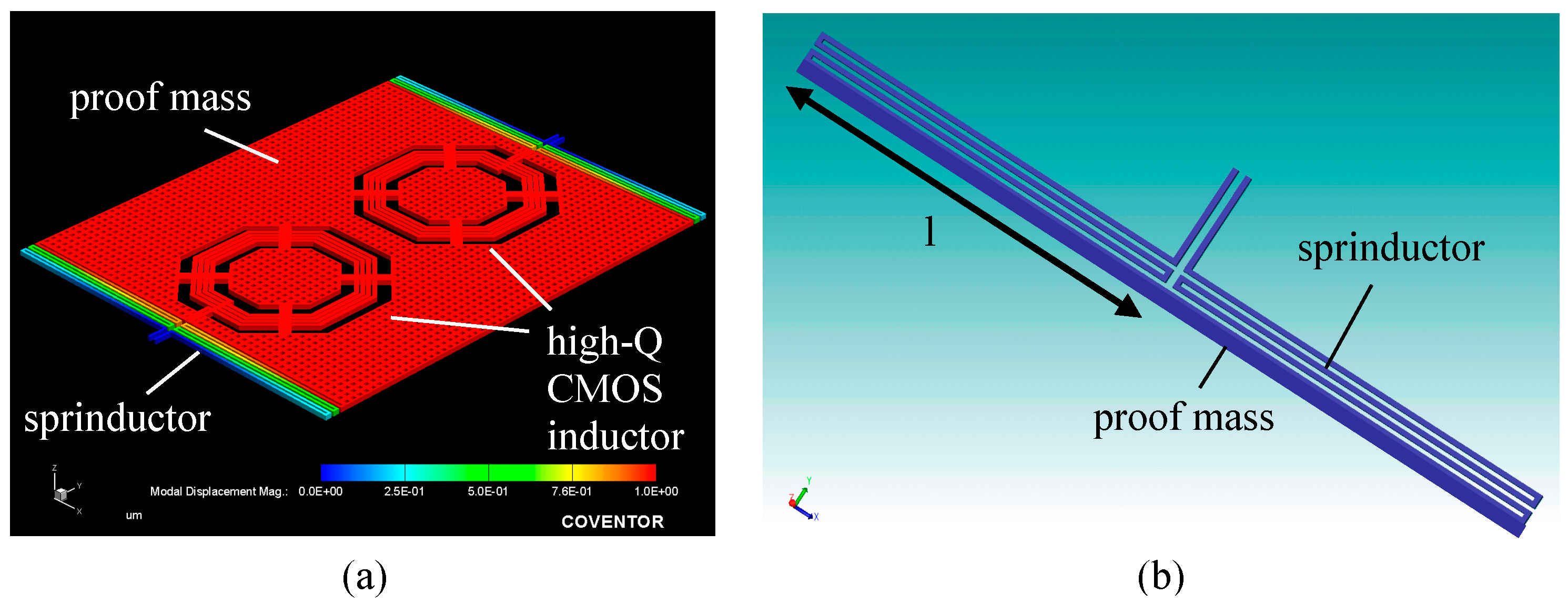
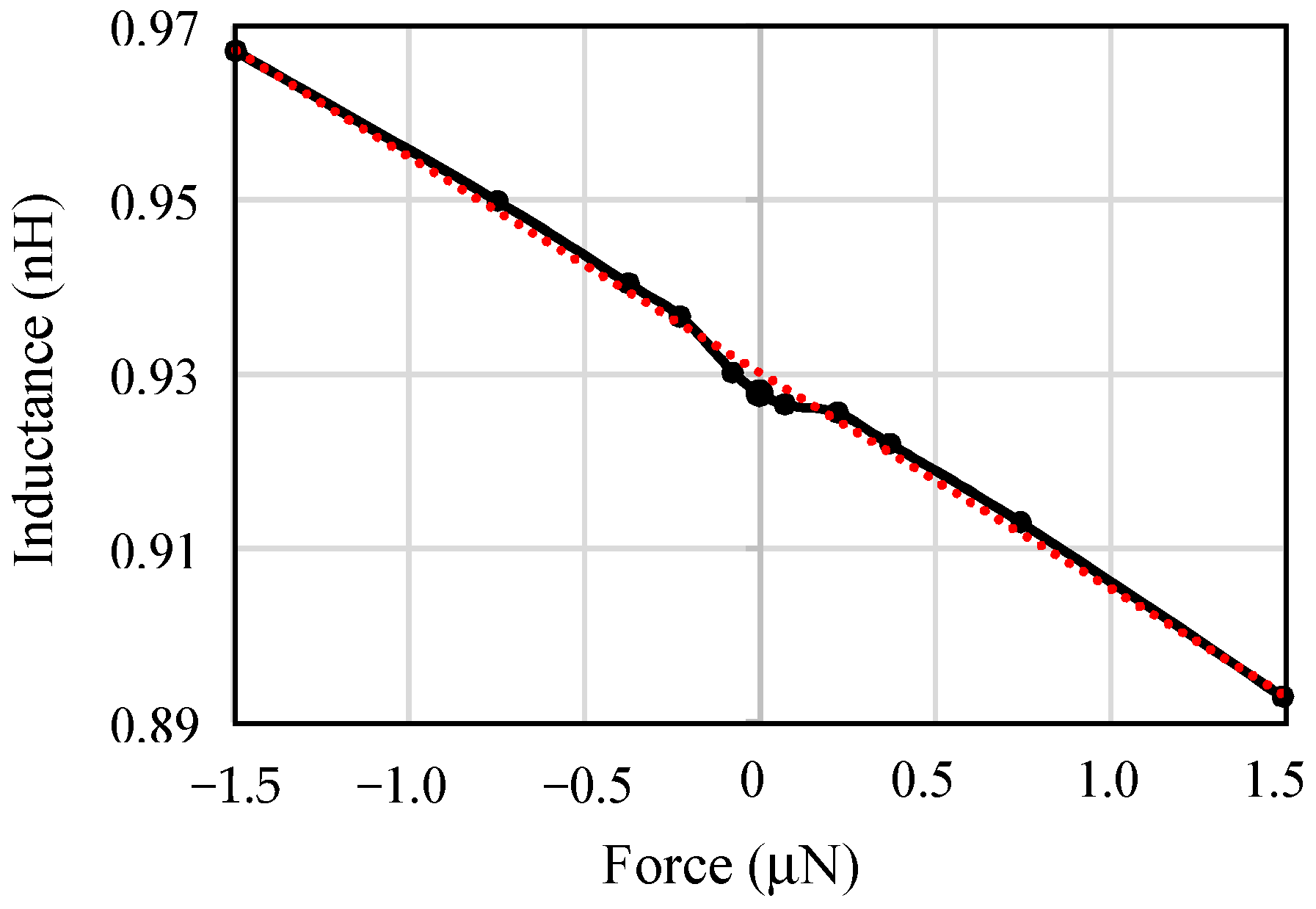


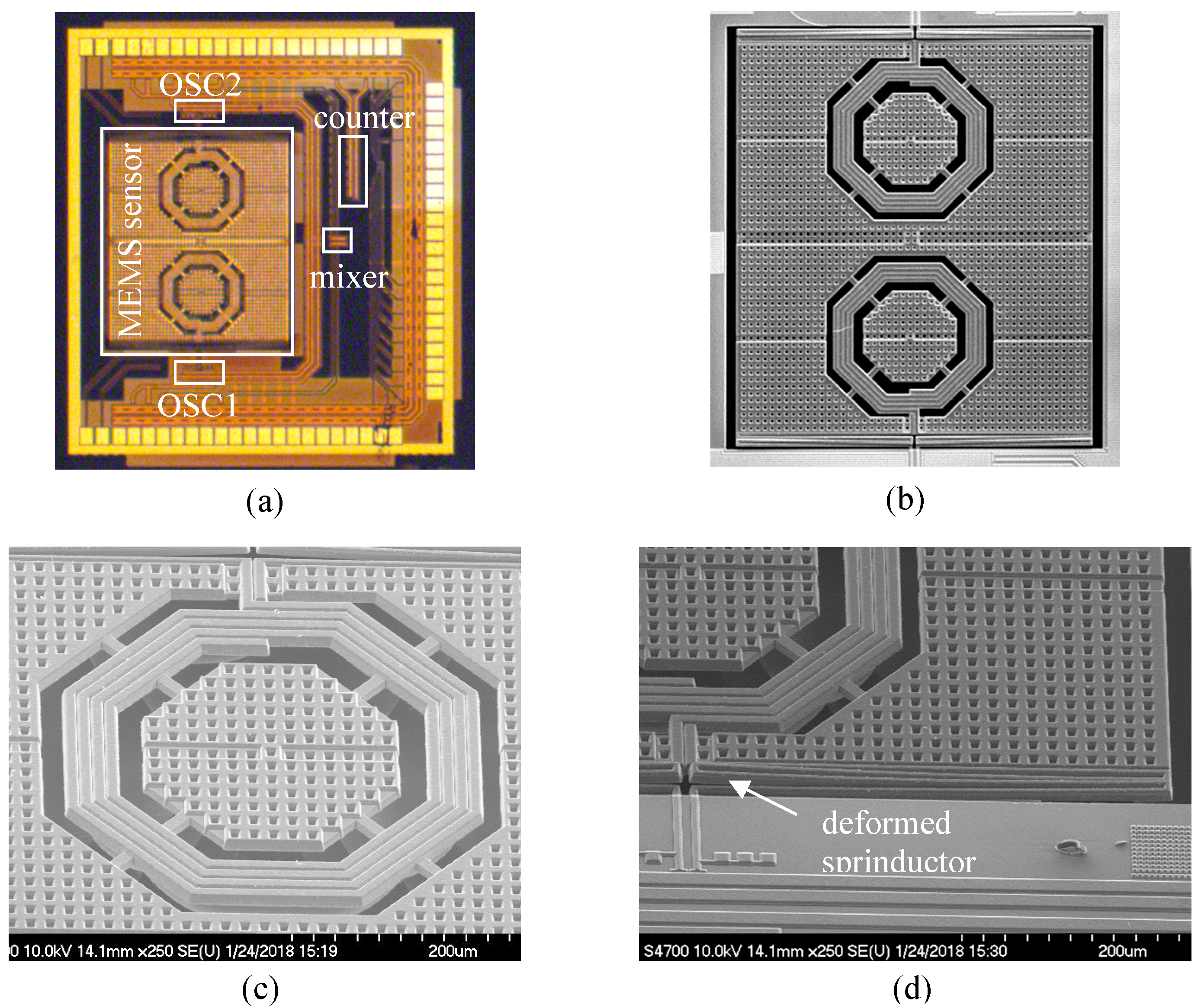



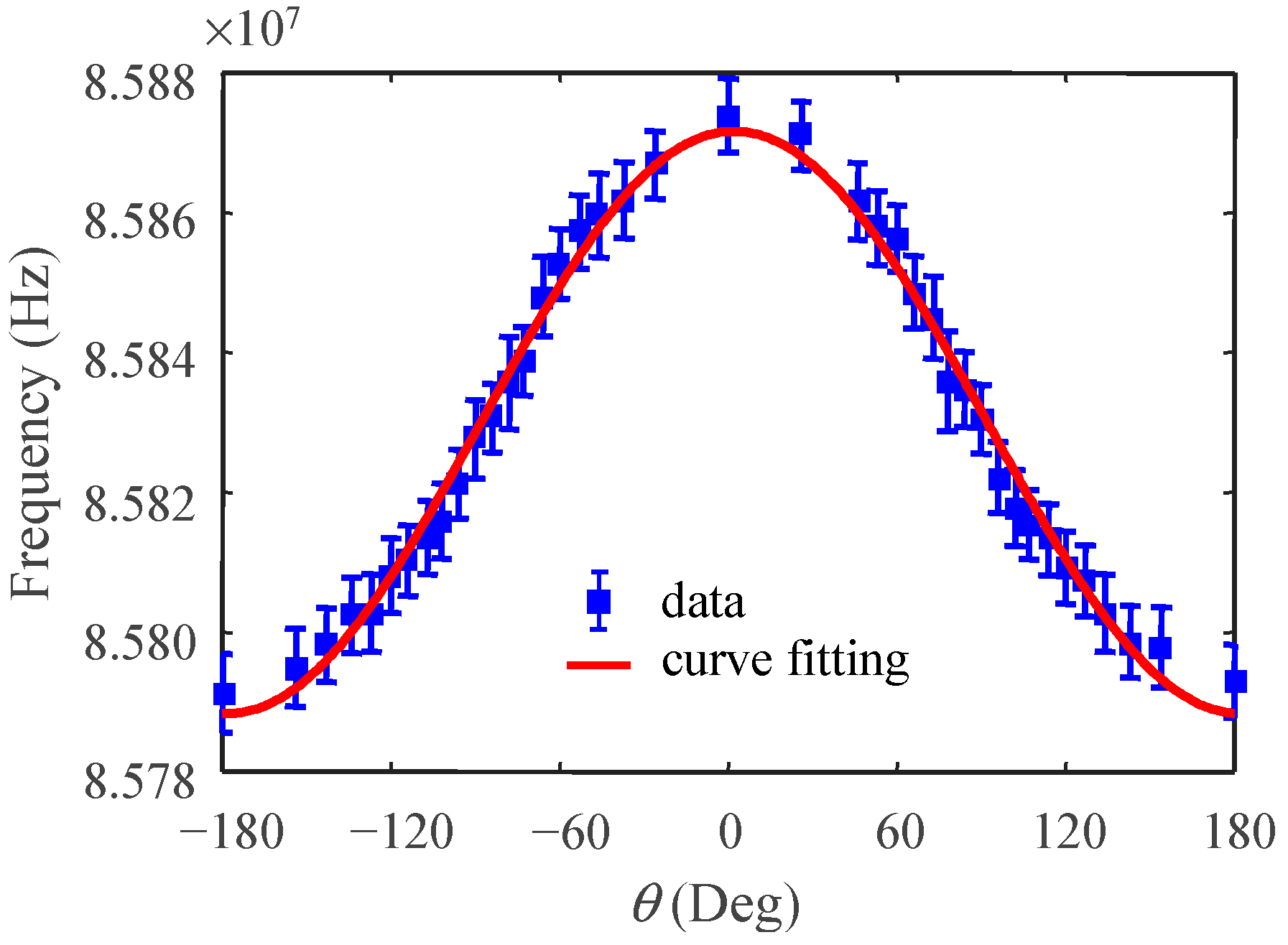

| Item | L (nH) | Q | |
|---|---|---|---|
| Low-Q MEMS sprinductor | = 0.92 | = 7.92 | = 0.88 |
| High-Q CMOS inductor | = 8.91 | = 9.34 | = 7.19 |
| Total inductor | = 9.83 | = 17.26 | = 4.29 |
| CMOS Tech. (𝛍m) | Type 1 | Sensing Element | Sensitivity (/g) | Noise Floor (mg/√Hz) | Nonlinearity (%FS) | Output 4 | Reference | ||
|---|---|---|---|---|---|---|---|---|---|
| 0.35 | C | on-chip | 8.8 | NA 5 | 105 mV | 0.4 | 1.0 | A | [2] |
| 0.18 | C | on-chip | 4.7 | NA 5 | 191 mV | 0.35 | 1.0 | A | [3] |
| 0.18 | C | on-chip | 7.0 | 1.9 | 3.6 MHz | 0.2 | 1.2 | A | [4] |
| 0.13 | I | bond wire | 3.1 | 2.1 | 10 kHz | 80 | - | A | [8] |
| 0.18 | I | on-chip | 6.6 | 2.0 | 22 kHz | 460 | 11 | A | [9] |
| 0.18 | I | on-chip | 4.5 | 1.4 | 42 kHz | 8 | 1.5 | A/D | This work |
© 2019 by the authors. Licensee MDPI, Basel, Switzerland. This article is an open access article distributed under the terms and conditions of the Creative Commons Attribution (CC BY) license (http://creativecommons.org/licenses/by/4.0/).
Share and Cite
Chiu, Y.; Liu, H.-W.; Hong, H.-C. A Robust Fully-Integrated Digital-Output Inductive CMOS-MEMS Accelerometer with Improved Inductor Quality Factor. Micromachines 2019, 10, 792. https://doi.org/10.3390/mi10110792
Chiu Y, Liu H-W, Hong H-C. A Robust Fully-Integrated Digital-Output Inductive CMOS-MEMS Accelerometer with Improved Inductor Quality Factor. Micromachines. 2019; 10(11):792. https://doi.org/10.3390/mi10110792
Chicago/Turabian StyleChiu, Yi, Hsuan-Wu Liu, and Hao-Chiao Hong. 2019. "A Robust Fully-Integrated Digital-Output Inductive CMOS-MEMS Accelerometer with Improved Inductor Quality Factor" Micromachines 10, no. 11: 792. https://doi.org/10.3390/mi10110792
APA StyleChiu, Y., Liu, H.-W., & Hong, H.-C. (2019). A Robust Fully-Integrated Digital-Output Inductive CMOS-MEMS Accelerometer with Improved Inductor Quality Factor. Micromachines, 10(11), 792. https://doi.org/10.3390/mi10110792





